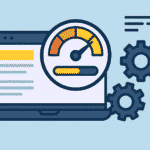Website Speed Optimization: Boost Performance for Better Ranking On Search Engines
Website Speed Optimization: How to boost performance for better rankings on Search Engines
We live in a world where attention spans are getting shorter and shorter everyday. People don’t have time to wait for anything, nor do they have the patience to wait for something. If they need something and they are not getting it swiftly, they will move on to the next in line competitor.
Same is the case with websites. When the visitor visits your website and it takes ages for your website to load, the visitor is most likely to switch to some other website with similar content. This also hurts in the long run as the user will know that your particular website is really slow and will likely never come back to visit your website again.
Hence, optimizing website speed and providing a good user experience has become vital for any business that wants to succeed online. Even Search Engines like Google, Bing, Baidu etc. are also putting a lot of emphasis on user experience and a slow loading website will have a negative impact on the search result rankings for a website.
It has become utmost important for website owners and developers to understand the importance of optimizing the website speed and also to understand the relationship of website speed optimization with SEO.
Optimizing website speed for better Google Rankings
Website speed is important not only to provide a seamless user experience but it has a vital role in SEO – Search Engine Optimization for the website as well. Google and other such search engines consider the website speed as one of the top ranking factors. In fact Google Search Console has a separate section dedicated to your website speed and user experience that tells you how your website is performing.
Slow loading websites can lead to higher bounce rates which in turn leads to very little time spent on your website by visitors and thus reduced conversions, but if the website is fast and loads quickly than it can greatly improve your user engagement and also increases the chances of visitors staying on your website for longer time. Check the Fastest WordPress Hosting Providers.

Understanding Website Speed and its Impact on User Experience
One of the most basic definition of website speed is the time it takes for a website to fully load. It includes many different factors such as size of the webpage, server response time, network latency etc. If a website is slow, it can frustrate the users and makes them more likely to leave your website. Studies have shown that a drop of a second in website loading speed could lead to lower conversion rates.
Core Web Vitals on Google Search Console and Website Speed
Google being the market leader in search engines has a separate section by the name of Core Web Vitals in its Google Search Console that specifically categorizes the webpages of the website into good, needs improvement or poor URLs categories based on the Page loading speeds.
A good Page Loading speed according to Google Search Console’s Core Web Vitals is under 2.5 seconds. If the webpage loading speed is between 2.5 to 4 seconds than it is categorized under Needs Improvement URLs. Finally anything above 4 seconds is categorized as Poor URL.
You can see the report of your website for both Mobile and Desktop pages. This just shows that Google takes website speed as one of the most important factor when it comes to Search Engine rankings.
Popular Read: Choosing the Fastest WordPress Hosting for Your Website
Related: Boost Website Speed: Ultimate Guide to Faster Loading Times
Also Read: The Ultimate Guide to Choosing the Best VPN for Secure Online Banking
Website Speed Optimization – Boost Site Performance for better Rankings | Best Practices and Techniques for Improvement
In order to improve your Website’s Loading Speed or Website Speed Optimization, you first need to analyze your website’s current performance and from there on you need to find out which areas are in need of improvement.
Analyzing the Website Loading Speed
Now you will have a question in mind that How can I analyze my website’s loading speed or current performance? There are lots of tools available for you to analyze your website’s performance. You can use Google PageSpeed Insights or GTmetrix to assess the performance and you can also identify the areas of improvement using these tools. Following are the links to these tools:
- Google PageSpeed Insights: https://developers.google.com/speed/pagespeed/insights/
- GTmetrix: https://gtmetrix.com/
- Pingdom: https://www.pingdom.com/
Caching and Compression to Boost the Loading Speed
Some of the most effective things you can try for your website to reduce the load on your web server and improve the loading time is to use Caching and Compression.
Caching involves storing static files, such as CSS, HTML and JavaScript. The files are stored on the server or user’s browser. When a user revisits your website the cached files are then retrieved from the browser or server rather then going through the whole process of requesting the file and then getting the files and then loading then it will just load them and thus improving the loading time of your website.
Compression reduces the file sizes of your website’s resources thus improving the loading speed. Both of them can be used simultaneously and will boost your website’s loading speeds. This is one of the best techniques for website speed optimization.

Optimizing Images and Reducing File Sizes
Images are probably the biggest contributors in a slow performing website. Size of images can be an issue for the website. More images mean more loading time required for the website. But Images are a necessity and without them your website will be bland.
In order to overcome this issue, you should optimize the images and reduce the file sizes of these images so that the loading time gets shorter. Compress the images using tools available on the internet. A simple google search will yield lots of such tools. Make sure the image quality is not reduced when you compress the image. Image types like JPEG and WebP offer good compression and are relatively lesser in size. Use them rather then using bulky images.
Another tip is to use Lazy Loading Images, which loads the image when you reach that part of the webpage thus reducing the initial load times for your website. Use a plugin to use Lazy Loading Images. Any good cache plugin should have a Lazy Loading Image setting.
Also Read: How to get rid of Advanced-Cache.php error in WordPress
Also Read: Things to Look Out for When Choosing a Web Hosting Service in 2023
Minimize CSS and JavaScript Files
Some of the most essential files for your website’s design and functionality to work are CSS and JavaScript files. Without them your website might not function properly but they can be a cause of slow loading website or slow website loading speeds.
Try to combine and minify the CSS and JavaScript files by using a plugin to reduce their size and minimize the number of requests required to load them. This will make your website a bit more efficient and in doing so will improve your website loading speed.
Another good tip is to remove any unwanted code or unnecessary comments from your website as they might be making your website slow. If you are not an expert in coding then don’t try this step.
Use Content Delivery Networks – CDNs
Content Delivery Networks (CDNs) are a network of servers distributed across various locations globally. They store copies of static files of websites on these servers and the CDNs can deliver content to users from the server closest to their geographical location.
This improves network latency and improves website loading speed thus ensuring faster page load times. These CDNs might charge you for there services but most of them have a free limit that you can use for free.
Continuously Monitor Your Website’s Performance for better website speed optimization
Monitoring your website’s performance is an ongoing process. Keep a check of your website speed and co-relate it with the traffic to see if it has a significant impact on your website rankings. You should be regularly checking your website’s speed with free or premium tools like GTmetrix or Pingdom etc. These tools can provide insights into areas that need further optimization and help you stay on top of any potential issues that may arise.
Popular Read: How to Create a Baidu Account from Outside China without Chinese Phone Number
Also Read: How to Watch Videos not available in your Country from Anywhere
Conclusion
One will always prefer a fast loading website over a slow loading website if the content is similar. Tweaking your website’s settings in order to boost your site’s loading speed is not rocket science, but make sure you back up your site before making any changes just in case something goes wrong. Find Best WorPress Hosting Providers here.
Even if you are not an expert you can still boost the site’s speed by following the techniques mentioned above. See what works for you and stick to it. Website Speed Optimization is going to make your website only better.
Follow us on Facebook, Instagram and Twitter to stay updated.
Share this post on Website Speed Optimization with your friends and family.
This post was on Website Speed Optimization: How to boost performance for better rankings
Happy Reading!
Also Read on Infinity Folder
- How to keep your Child away from Technological Gadgets and Devices
- How to Create Baidu Account from Outside China without Chinese Phone Number 2025
- Beginner’s Guide on Why and How to Shop from AliExpress
- How To Keep Your Kids Busy During COVID-19 Pandemic
- How to clear up space on outlook.com and fix “Your Mailbox is full” prompt
- How to Watch Videos Not Available in Your Country (2025 Guide)
- Beginner’s Guide on Why and How to Shop from Amazon
- How To Fix The Email Attachments Not Opening Problem On Outlook.com
- How to Turn on LED Flash Light for Alerts and Notifications on iPhone
- How to fix the Printer not Printing Problem on Windows
- Auto Archive in Outlook – Step-by-Step Instructions
- The Ultimate Guide to Choosing the Best VPN for Secure Online Banking
- How to Protect Your Online Privacy: A Complete Beginner’s Guide
- Outlook Storage Full? Outlook Mailbox Full Fix in 7 Easy Steps







